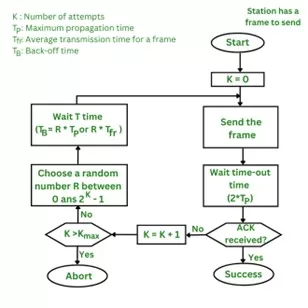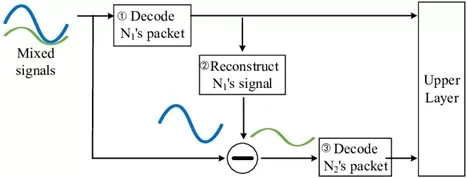Overview of CRDSA
Contention Resolution Diversity Slotted ALOHA (CRDSA) represents a significant evolution in the domain of random access protocols, particularly suitable for environments like the Industrial Internet of Things (IIoT), where communication efficiency, reliability, and rapid response are paramount. CRDSA builds upon the foundations of the traditional ALOHA and its more structured variant, Slotted ALOHA, by introducing key innovations that drastically improve the protocol’s performance in congested networks.
CRDSA was developed as an enhancement to Slotted ALOHA, which itself was a response to the inefficiencies observed in the original ALOHA system.
The fundamental idea behind ALOHA is simple: allow devices to transmit data whenever they have data to send, without the need to check if any other device is transmitting at the same time. This method is known as “pure ALOHA.” It is a random access protocol because transmissions are made at random without coordination between devices, leading to a possibility of collisions (i.e., overlapping transmissions that corrupt transmitted data).

Figure 1: Pure ALOHA
In pure ALOHA:
- A device will send a data packet whenever it has data ready to transmit.
- If the packet successfully reaches the receiver without interference from other packets, an acknowledgment is sent back to the sender.
- If there is a collision, the packet will be corrupted, and no acknowledgment will be received. The sender then waits for a random amount of time before retransmitting the packet.
In the pure ALOHA setup, devices transmit their data packets whenever they have data to send, leading to high collision rates, especially as the number of devices increases. Slotted ALOHA improved upon this by dividing time into discrete slots and allowing devices to transmit only at the beginning of these slots, effectively reducing collisions but not eliminating them.
CRDSA takes this a step further by implementing a simple yet effective twist to the process: each packet transmission includes one or more additional replicas of the packet sent during other randomly selected slots within the same frame. This redundancy allows the protocol to leverage advanced signal processing techniques to resolve packet collisions, a feature absent in its predecessors.
Adaptive Features of CRDSA
Contention Resolution Diversity Slotted ALOHA (CRDSA) is particularly valued in the Industrial Internet of Things (IIoT) for its adaptive features, which allow it to dynamically adjust its operation based on real-time network conditions. This adaptability is crucial in industrial settings where network traffic can vary dramatically and unpredictably, often influenced by the operational demands of the factory floor, automated processes, and sensor reporting intervals.
Dynamic Adjustment of Replicas:
One of the key adaptive features of CRDSA is its ability to control the number of replicas for each packet transmission. The protocol can vary the number of replicas based on observed network conditions such as the current load, packet success rates, and collision frequencies. In scenarios with low traffic, fewer replicas might be needed, conserving bandwidth and reducing the possibility of unnecessary collisions. Conversely, in high traffic conditions, increasing the number of replicas per packet can significantly enhance the probability of successful packet recovery through successive interference cancellation, even in dense and noisy environments.
This dynamic adjustment is typically governed by algorithms that analyze historical network performance data to predict optimal transmission strategies. These algorithms can be designed to prioritize different network goals, such as maximizing throughput, minimizing delay, or conserving energy.
Successive Interference Cancellation (SIC):
The core mechanism that sets CRDSA apart is its use of Successive Interference Cancellation (SIC). The ability of CRDSA to adapt also extends to its use of SIC, a powerful tool that allows the protocol to iteratively decode packets from a collision. SIC adapts to the specific conditions of each collision event. When a collision occurs, SIC enables the receiver to use the information from successfully received packets to reconstruct and subtract interfering signals.

Figure 2: Successive Interference Cancellation Diagram
This process reveals packets that were originally obscured by collisions.
For example, the receiver initially captures mixed signals, which include overlapping transmissions from different nodes, such as 𝑁1N1 and 𝑁2N2, where their packets have collided. The first step involves decoding 𝑁1N1’s packet from these mixed signals. Once 𝑁1N1’s packet is decoded, the receiver reconstructs 𝑁1N1’s signal accurately.
This reconstructed signal of 𝑁1N1 is then subtracted from the mixed signals, effectively isolating 𝑁2N2’s signal by removing 𝑁1N1’s interference. With 𝑁1N1’s signal canceled out, 𝑁2N2’s packet can now be decoded clearly.
Finally, the successfully decoded packets are forwarded to the upper layer for further processing, illustrating how SIC enhances network throughput and efficiency by resolving collisions and recovering obscured packets.
Each packet and its replicas contain pointers to each other’s locations within the frame. This critical piece of information allows the receiver to effectively apply SIC and significantly increases the likelihood of recovering collided packets.
Feedback Mechanisms:
CRDSA incorporates feedback mechanisms that allow network devices to report back on the success or failure of their transmissions. This feedback is used to adjust the protocol’s parameters, such as the timing of transmissions and the allocation of slots for replicas. Feedback can also trigger adjustments in the protocol’s approach to error correction coding, power levels used in transmissions, and even the scheduling of maintenance or calibration communications to optimize network performance.
Handling of Network Variability:
Industrial environments are prone to rapid changes in network conditions due to varying operational demands. CRDSA’s adaptive features are designed to handle this variability efficiently. By adjusting how and when data is transmitted based on real-time assessments of network status, CRDSA can maintain high levels of reliability and availability, essential for critical IIoT applications where downtime or delays could have significant repercussions.
Energy Efficiency:
Finally, the adaptive nature of CRDSA also contributes to enhanced energy efficiency, a critical consideration for battery-operated sensors and devices prevalent in IIoT settings. By optimizing the number of transmissions and leveraging successful packet receptions, CRDSA minimizes unnecessary retransmissions, thereby conserving energy and extending device lifespans.
The adaptive features of CRDSA make it an exceptionally robust and efficient protocol for IIoT communications. Its ability to dynamically adjust to changing network conditions, coupled with sophisticated mechanisms like SIC and intelligent feedback utilization, ensures that CRDSA can support the complex, variable demands of modern industrial environments with enhanced efficiency and reliability.
Benefits of CRDSA in IIoT Communications
Contention Resolution Diversity Slotted ALOHA (CRDSA) offers significant benefits tailored specifically to the demanding environments of the Industrial Internet of Things (IIoT). Its advanced features not only resolve some of the longstanding challenges of network communications but also enhance operational efficiency and reliability—key metrics in industrial applications.
Enhanced Throughput and Network Capacity: One of the standout benefits of CRDSA is its ability to significantly increase network throughput and capacity. By effectively resolving packet collisions through the use of packet replication and SIC, CRDSA allows a greater number of devices to communicate simultaneously without a proportional increase in failed transmissions. This is particularly advantageous in IIoT settings where the density of network-connected devices can be extremely high. The improved throughput ensures that data from sensors and machines is transmitted timely and reliably, facilitating real-time monitoring and control, which are crucial for optimizing industrial processes.
Reduced Communication Latency: CRDSA reduces the latency typically associated with packet collisions in random access communication systems. In traditional systems, packets involved in collisions usually require retransmission, leading to higher communication delays. However, CRDSA’s ability to recover collided packets via SIC minimizes the need for retransmissions, thereby reducing latency. For IIoT applications where millisecond-level communication delays can significantly impact operational efficiency, such as in automated manufacturing lines or real-time remote control systems, CRDSA’s low-latency network access is a significant benefit.
Improved Energy Efficiency: Energy efficiency is critical in IIoT environments, particularly for devices that are remote or difficult to access, as these often operate on limited battery power. CRDSA contributes to energy conservation by reducing the number of retransmissions required, thanks to its efficient collision resolution mechanism. Fewer retransmissions mean lower energy consumption and extended battery life, which can lead to significant cost savings and more sustainable operations in terms of energy use.
High Reliability and Error Resilience: The industrial sector requires communications protocols that can guarantee high reliability due to the often critical nature of its operations. CRDSA enhances reliability by ensuring that even in the event of high traffic volumes or significant interference, data packets can still be successfully transmitted and decoded. This resilience to errors and ability to operate effectively under stress make CRDSA ideal for industrial applications where failure can result in significant downtime or safety risks.
Scalability: CRDSA’s scalability is a key advantage in the rapidly expanding ecosystem of IIoT. As more devices become networked, the ability of the communication protocol to scale without a degradation in performance is crucial. CRDSA’s use of adaptive packet replication allows the network to handle an increasing number of devices smoothly, making it easier for businesses to scale up their IIoT operations without needing to overhaul their communications infrastructure.
Adaptability to Diverse Industrial Environments: Finally, the inherent adaptability of CRDSA to different network conditions—enabled by its dynamic control of packet replicas and SIC capability—allows it to be tailored to a wide range of industrial settings. Whether dealing with high-density environments or areas prone to significant electromagnetic interference, CRDSA’s parameters can be adjusted to maintain optimal performance.
In conclusion, CRDSA addresses several critical needs in IIoT communications through its innovative approach to handling network access and traffic. By enhancing throughput, reducing latency, improving energy efficiency, and offering high reliability and scalability, CRDSA presents itself as a potent solution for modern industrial communication challenges, driving the efficiency and reliability of IIoT to new heights.
Challenges and Considerations
While Contention Resolution Diversity Slotted ALOHA (CRDSA) offers significant benefits for the Industrial Internet of Things (IIoT), there are several challenges and considerations that must be addressed to fully realize its potential. These challenges stem from both technical and operational aspects of implementing CRDSA in real-world IIoT environments.
Computational Demands of SIC: Successive Interference Cancellation (SIC) requires sophisticated signal processing capabilities, which can be computationally intensive. Implementing SIC effectively demands high processing power, which may not always be feasible for low-cost or low-power IIoT devices. The need for powerful processors can increase the cost and energy consumption of devices, potentially limiting the scalability of CRDSA-based solutions in cost-sensitive industrial applications.
Timing and Synchronization Requirements: CRDSA’s efficiency relies heavily on precise timing and synchronization among devices to ensure that packet replicas are correctly aligned and that SIC can be successfully applied. Achieving this level of synchronization in a distributed and often heterogeneous IIoT environment can be challenging. Delays, jitter, and drift in timing sources can degrade the performance of CRDSA, leading to increased packet collisions and reduced throughput.
Dynamic Network Conditions: IIoT environments are characterized by dynamic network conditions that can change rapidly, such as fluctuating traffic patterns and variable interference levels. Although CRDSA is designed to adapt to changing conditions, continuously monitoring the network and adjusting protocol parameters in real-time can be complex. There is also a risk of overfitting the system’s responses to transient changes, which could lead to instability in the network performance.
Scalability and Flexibility: While CRDSA is scalable, its scalability is contingent on the ability to maintain high levels of performance as the number of devices increases. The overhead associated with managing multiple packet replicas and the increased probability of collisions in extremely dense networks pose significant challenges. Furthermore, the protocol must be flexible enough to accommodate a wide range of device types and communication patterns typical in diverse IIoT scenarios.
Energy Efficiency Concerns: Although CRDSA helps reduce energy consumption by decreasing the need for retransmissions, the energy used in transmitting multiple packet replicas and processing SIC can offset these gains, especially in battery-operated devices. Balancing the benefits of increased reliability and throughput with the cost of higher energy use is a critical consideration for deploying CRDSA in energy-constrained environments.
Integration with Existing Systems: Integrating CRDSA into existing communication infrastructures, which may already use different protocols and technologies, presents another set of challenges. Compatibility with legacy systems, interoperability between different communication standards, and the potential need for significant infrastructure upgrades can impede the adoption of CRDSA.
Regulatory and Spectrum Considerations: Implementing CRDSA may also involve navigating complex regulatory environments, particularly concerning spectrum use. CRDSA’s efficiency partly relies on the ability to freely transmit multiple replicas across different frequency slots, which might not align with current spectrum allocation policies or may lead to interference with other services.
While CRDSA offers a compelling solution for improving IIoT communications, addressing these challenges is essential for its successful implementation. Overcoming these obstacles will require a combination of advanced hardware, sophisticated software algorithms, and strategic network management to ensure that CRDSA can deliver on its promise of transforming industrial communications.
Conclusion
As we look toward the future of CRDSA within the IIoT, it’s clear that CRDSA is poised for transformative advancements that promise to revolutionize industrial communications. By integrating with emerging technologies such as IoT, AI, and edge computing, CRDSA will enhance its adaptive capabilities and efficiency, facilitating real-time traffic management and robust data security.
Advancements in modulation and coding techniques will improve CRDSA’s data transmission efficiency, crucial for sectors like manufacturing and logistics. Broader standardization will ensure seamless integration across various platforms, essential as the IIoT ecosystem expands.
Regulatory changes and spectrum management will be critical in optimizing CRDSA for growing wireless communication demands, particularly in ultra-dense networks. Innovations in energy efficiency will also be pivotal, especially for battery-operated IIoT devices, enhancing sustainability and reducing operational costs.
The implications of these advancements are profound. Enhanced CRDSA protocols could lead to more robust automation systems, better process monitoring and control, and improved operational efficiency across multiple sectors. As industries evolve towards more interconnected systems, CRDSA will play a crucial role in enabling these transformations, leading to smarter, more responsive industrial environments.
References
- 3GPP (2021) TR 38.825 V16.0.0-Technical Specification Group Radio Access Network; Study on NR industrial Internet of Things (IoT); (Release 16) (2021)
- Laya, L. Alonso, and J. Alonso-Zarate, “Is the random access channel of LTE and LTE-A suitable for M2M communications? a survey of alternatives,” IEEE Communications Surveys Tutorials
- Babich et al. “Energy-Constrained Design of Joint NOMA-Diversity Schemes with Imperfect Interference Cancellation”. Sensors 2021
- Abramson.“The ALOHA System: another alternative for computer communications”. (AFIPS). ACM. 1970, pp.281–285.

